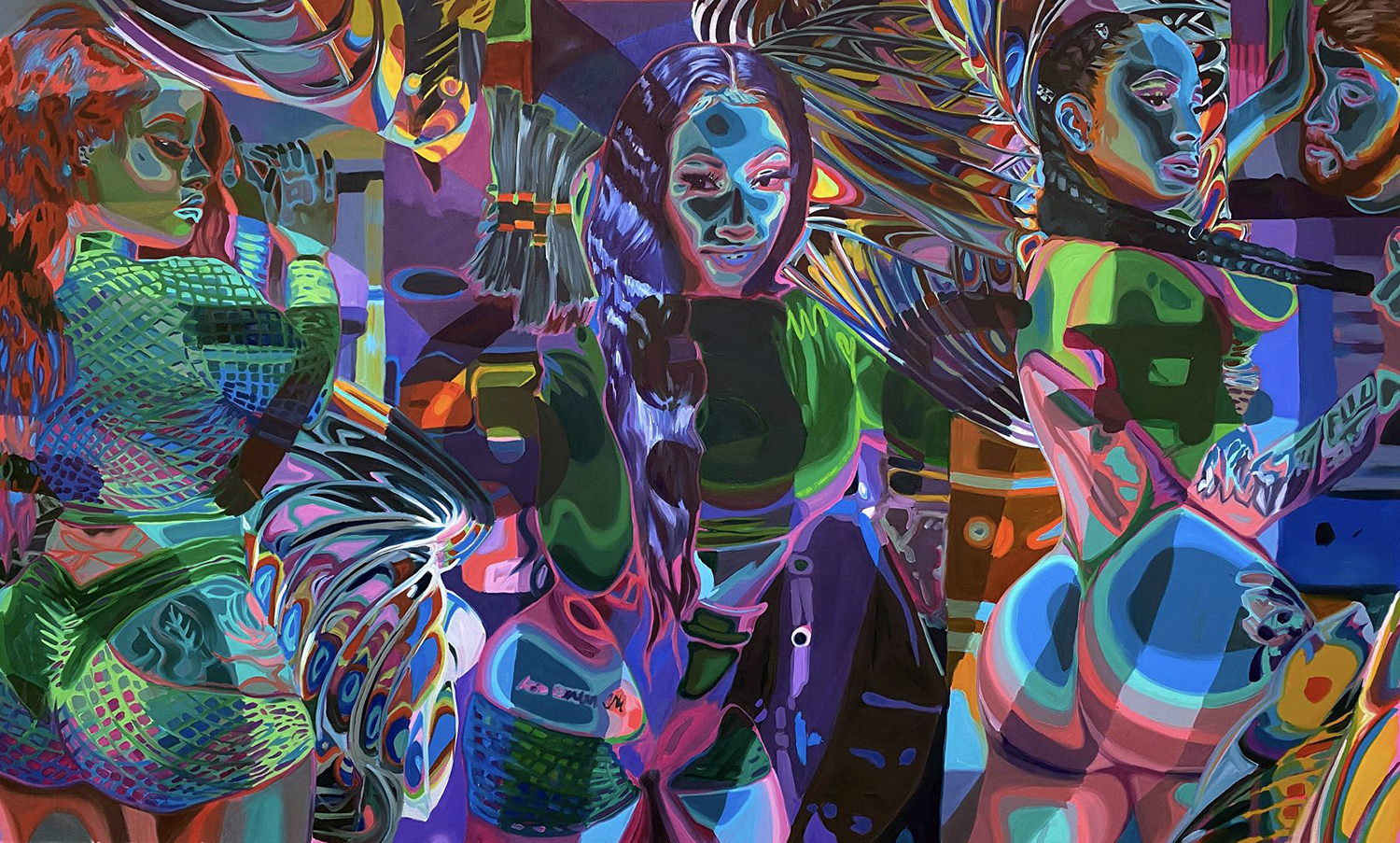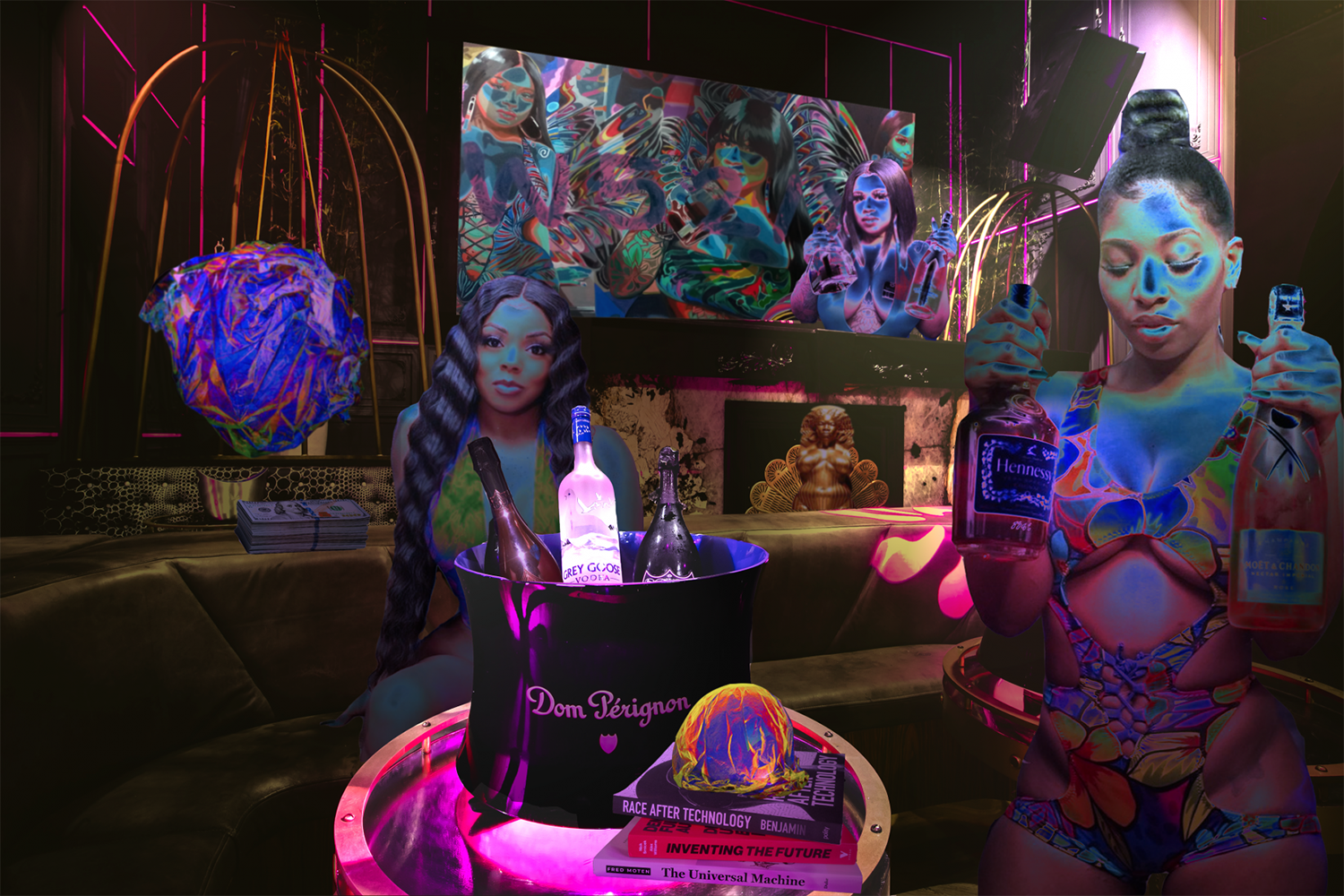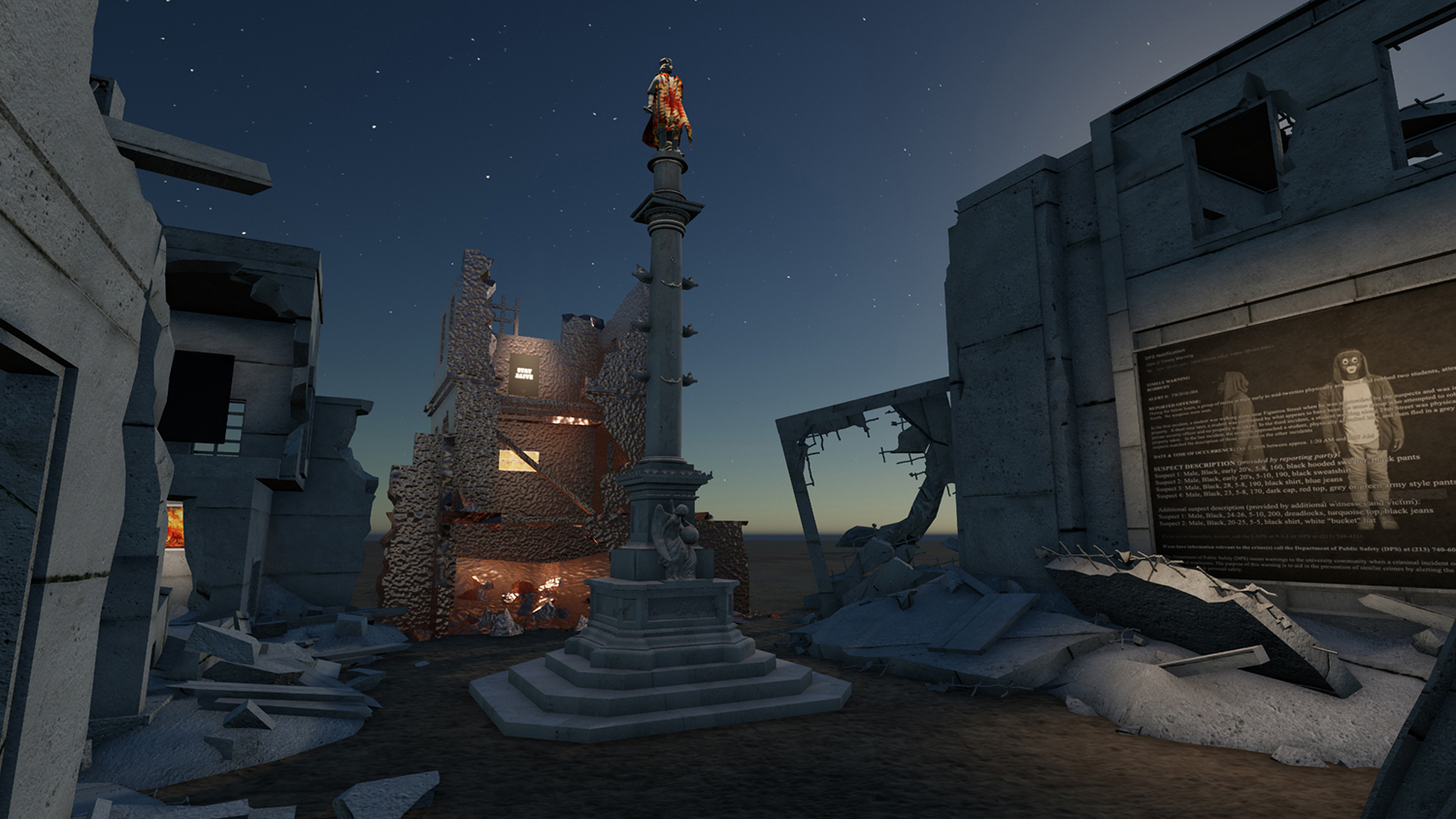Virtual Eyes: Art Criticism in the Online Gallery
Anuradha Vikram
December 2020
Galleries have been hit hard by the quarantine. Events are cancelled, artists can’t travel, and no one likes looking at art online. As an art writer, it seems insufficient to respond to these challenges with an exhibition review given that the form of the exhibition as we know it is now inaccessible. Criticism must adapt as artists and galleries have done. As the year ends and most galleries remain closed, I wanted to review two of the best online exhibitions I have seen during the 2020 pandemic while assessing the limits and possibilities of this changed terrain. These shows stand out for being visually interesting enough to transcend the mediated frame that places unwelcome distance between the viewer and the artwork.

Caitlin Cherry: Corps Sonore. Courtesy of Luis de Jesus Gallery.
Caitlin Cherry: Corps Sonore at Luis de Jesus
Caitlin Cherry’s Corps Sonore at Luis de Jesus is a virtual exhibition that is successful in part because the work is already about internet vision. The women in Cherry’s paintings style themselves to circulate as reproductions on digital platforms, attracting attention – and with it, capital. Cherry’s paintings are large and intricate. She favors a jewel and neon palette, the colors of the nightclub selfie. Curator and writer Marisa Olson, who contributed an essay on Cherry’s work, asks, “Can there be a critical viewing room curatorial practice?” To which I respond; Can there be an art criticism of the viewing room?
“Can there be a critical viewing room curatorial practice?” To which I respond; Can there be an art criticism of the viewing room?
Cherry’s work activates the undercurrents of the internet by acting (as Olson puts it) as “a fast track to the VIP Lounge.” The art gallery is already operating according to the politics of the VIP Lounge, trading objects in back rooms, communicating with those who need to know. Cherry’s Black femme beauties, women who trade in images of themselves on the internet, are in dialogue with women whose bodies have been commoditized by painters since the start of the modern era. Bottle girls reflect prismatically in a hall of mirrors, their impatient glances and evasive nods unchanged since Manet painted the bartender at the Folies-Bergere. What Manet sought out in the white working-class women he painted was this look of independence from the systems that commoditize and fetishize the female, laboring body in the new city of spectacle. 150-plus years later, the Black women who linger in the corners and the shadows of his paintings, underexamined, claim center stage in Cherry’s Domain Vagues (Art McGee) and In Vivo and In Silico (both 2020).
The contemporary internet is a cultural battleground, where racial justice, sexual liberation, and gender fluidity compete with a fixed and binary worldview perpetuated by QAnon trolls and tech bros.
The extreme femininity of Cherry’s subjects adheres to an anti-natural, Mannerist ideal of the body as a site for social commentary. The contemporary internet is a cultural battleground, where racial justice, sexual liberation, and gender fluidity compete with a fixed and binary worldview perpetuated by QAnon trolls and tech bros. Mannerism emerged from another period of extremes in Renaissance Europe, as the liberal hedonism of the Medicis gave way to the severe asceticism of Savonarola. In this time of great social upheaval, Botticelli painted Venus, later burning all his work in a bonfire of shame at the sensual pleasure that looking at his paintings inspired. Curvaceous, bound, and unbothered, Cherry’s Slasher (2020) knows the secret of Venus. Beautiful women make people lose their minds.
The Mannerist body is shaped by social factors, class status, and desire, bridging the muscular goddesses of Michelangelo with the spineless harem girls of Ingres. In those historical works, Black women are everywhere yet invisible. Like those women were emblems of their time, Cherry’s femmes perform the culture of the moment with their bodies. But they wear their Black identity on the surface, while other aspects of their self-construction remain coded. Painters in the modern era make work about painting, about the image, about the frame as a window into alternate perceptual spaces. Cherry’s women are a synthesis of many selves, further collapsed by the framing of their images on the internet that inevitably parallels the origins of the images as social media posts.

Caitlin Cherry: Corps Sonore. Courtesy of Luis de Jesus Gallery.
These paintings make sense on the internet – and they look good on the internet! They are bright and detailed with many hidden elements that emerge on repeated looking. This is a benefit because the works are competing with text in nearly every online viewing room. Designers are unsure whether the viewing room is a catalogue or, as Olson puts it, “a live PDF.” The design is mostly organized around blocks of too-small text and large detail shots of Cherry’s paintings and digital collages. These blow-ups are helpful because they show the texture and paint handling in much greater detail. Indistinct and fragmented, the figures in the scrolling details read more cinematically than the same figures in a complete photograph of the painting. It is impossible to know from the viewing room whether this effect happens when viewing the actual paintings from specific angles. The patterns that striate the women’s bodies, constructed in Cherry’s narrative as visual camouflage that shields her figures from disempowerment by an all-consuming gaze, become a whirlwind of perceptual shifts in close up detail.
A digital study that serves as the header for the virtual viewing room features several barely-dressed, pleasure-seeking femmes in a nightclub/palace adorned with Cherry’s art. In the foreground, a stack of books stakes out the intellectual space in which the artist intends to play. Apart from questions of how primitive accumulation accrues to and through her subjects through the proliferation of their social capital – ideas referenced in several of these books and statements by the artist – is the question of whether Black women are implicitly posthuman, as Cherry’s reading list also seems to suggest. Cherry’s moiré palette is an act of refusal that disrupts the centuries-old exchange of Black women’s bodies for capital, transactions that have situated Black women as tools for domestic, reproductive, and sexual labor that they do not control. Reading Helen Hester’s Xenofeminism (an author from Cherry’s stack who says, “Being post-millennial cyborgs, our capacity to act is largely tethered to the everyday informational infrastructures with which we engage.”) we could say that Cherry’s paintings confront the distortion of value that organizes everything and everyone in the digital frame into a ranked hierarchy of competing commodities. The viewing room, as a format, reinscribes this distortion.

Fallen Monuments. Courtesy of EPOCH Gallery.
Fallen Monuments at EPOCH Gallery
The alternative to the commercial gallery is, as always, the artist-run space and Los Angeles artist Peter Wu has created a virtual viewing environment, EPOCH Gallery, to present artworks during the quarantine. Fallen Monuments, the second EPOCH exhibition, featured work by Gala Porras-Kim, York Chang, Ivan Argote, Marton Robinson, Conrad Ruiz, Allana Clarke, and Ricardo Rivera.
EPOCH is a hall of abandoned edifices, an island in an icy sea. When you enter you can hear what sounds like wind across the expanse. This is a sound work by York Chang, I Am Sitting in a Feedback Loop (2019). 3D models frame 2D works. The first I encounter is Marton Robinson’s Tecnologias Deculoniales: Slot Machine (2020). The image shows a Black man both in profile and straight-on with a central figure dressed in a cartoonish blackface mask. All three wear pants and hoodies: the two Black figures in black, and the “white” blackface figure in white. All three parts are played by one man. Text printed over the black and white image refers to suspects in an attempted robbery, transcripts from a typical email sent to USC students, faculty, and staff on a regular basis describing crimes and police incidents in the university area. Robinson’s work speaks to how these alerts made him, a Black student enrolled in the USC Roski School of Art and Design, fearful for the safety of his body on campus.
York Chang’s work emerges like an apparition from an abandoned virtual hallway. Antagonistics (Legacy Portrait 1) (2013) depicts a sitting man in a suit and tie with a collaged visage. This work is part of a series that Chang created as his alter ego, Gustavo Raynal, an alternate artistic persona that Chang has occupied for the purposes of the project. Antagonistics enables York Chang to act as a curator and interrogator to himself. The Pictures-style work in the next room are two works by Conrad Ruiz: Man on Fire X and XI (both 2020). These are watercolor paintings of photographs that show men with their upper bodies engulfed in flames. One, in a hard hat, pulls his burning shirt away from his chest. The other, in profile, covers his face with his hands as his wrists and shoulders ignite. Ruiz seems to relish the rendering of a sprawling, unruly fire, as the flame bursts break through otherwise orderly documentary-style images. Each of these works incorporates markers of traditional masculinity, violently disrupted.
Gala Porras-Kim’s Fallen Monuments after Ozymandias (2020) is an ever-growing collection of artworks that have been removed from sites around the world. On an empty beach at dusk, they lay strewn half-buried in the sand. The didactic panel quotes the titular poems by Percy Bysshe Shelley and Horace Smith created in a poetry “duel” in 1818. Both describe an abandoned land strewn with massive parts of dismantled sculptures. Shelley references ancient Egypt, Smith modern London. Porras-Kim preserves the otherworldly referent of Shelley’s poem, rendering visible the embodied stone he describes: “Two vast and trunkless legs of stone stand in the desert. Near them, on the sand, half sunk, a shattered visage lies.”1 The exhibition’s premise in the context of current events is more strongly evoked by Smith’s lines: “He meets some fragments huge, and stops to guess what powerful but unrecorded race once dwelt in that annihilated place.”2 Art reflects the transition from a world we knew to one that is yet to come.

Fallen Monuments. Courtesy of EPOCH Gallery.
Continuing to explore, I traverse the island by clicking on a map at the upper right of my screen. It bears noting that a decent visual processor and a separate monitor makes writing about art this way much easier; also that I experience Wu’s 3D modeled gallery environment as more innovative, more navigable, and better rendered than the Lehmann Maupin 3D gallery for Robin Rhode and Nari Ward’s Power Wall, which is a rendering based on photographs of an exhibition in the gallery’s physical space in Berlin.
Allana Clarke’s You Belong to Nothing and Nothing Belongs to You (2017) is a video work showing the artist’s shaved head through a spherical lens that renders her skin like a microscopic cell, or the surface of a planet. This questioning, uncertain experience of the everyday resonates with the sense of physical remove that we are developing during COVID. Another video work by Ricardo Rivera references the Golden Record produced by NASA with Carl Sagan which was sent into space in 1977 with the intention of initiating communication with interplanetary life forms. Working to the sounds of this record, which are meant to represent all of human culture, Rivera makes intuitive, symmetrical drawings using both of his hands separately. The artist becomes a psychological vessel for the range of our planetary cultural expressions, as Bruce Nauman jested, “by revealing mystic truths.”3
Ivan Argote’s Turista: Christopher Columbus, Columbus Circle, New York (2020) anchors the exhibition. The 3D virtual sculpture is a recreation of a gesture Argote has performed on other monuments in public space, dressing them in Indigenous ponchos as a visual challenge to their authority. Here, a yellow and red poncho adorns the Columbus Circle Monument in New York City, bearing the patterns of the upstate New York-based Mohawk tribe.
Monuments are falling. Galleries are closing. The future of exhibitions is not going to be exactly like the past. What can we expect art to do in times like these? What do we need from art? After months in quarantine, the greatest loss that virtual galleries cannot truly fill is the social dimension of art viewing. How can the critic help re-establish those connections between people that are facilitated by art and that the quarantine has temporarily severed? By offering up my eyes to you here, I hope to restore some intimacy to the art viewing experience.
Footnotes
Anuradha Vikram is a writer, curator, and educator based in Los Angeles, CA.